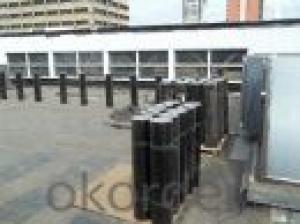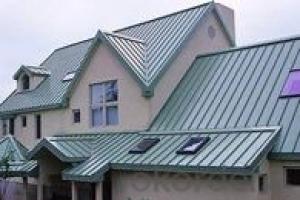Spunbond Polyester Mat /filament Polyester Mat For APP/SBS Waterproof Membranes
- Loading Port:
- Shanghai
- Payment Terms:
- TT OR LC
- Min Order Qty:
- 1000 m²
- Supply Capability:
- 200000 m²/month
OKorder Service Pledge
OKorder Financial Service
You Might Also Like
Product description
Produced by the Modern Waterproofing Company,Spunbond Polyester Mat /filament Polyester Mat For APP/SBS Waterproof Membranes is a line of polymer-modified bitumen waterproofing membrane of the highest quality.
Spunbond Polyester Mat /filament Polyester Mat For APP/SBS Waterproof Membranes is modified by SBS, thus guaranteeing high flexibility under very low temperature.
SBS Waterproofing membranes reinforced with Polyester suitable hot and cold atmospheres - Cold Flexibility -10 : -20 C
Spunbond Polyester Mat /filament Polyester Mat For APP/SBS Waterproof Membranes is reinforced with composite polyester (P) of non-woven polyester armoured with glass fiber filaments which provides highly mechanical properties and dimensional stability.
Spunbond Polyester Mat /filament Polyester Mat For APP/SBS Waterproof Membranes with Mineral Slated Finish is recommended for exposed roofing system (Unprotected) for Non-accessible roofs or roofs subject to low traffic conditions
Packaging & Shipping
Package and transportation-- SBS waterproof membrane / APP waterproof membrane / Asphalt waterproof membrane for building waterproofing construction :
1. Torch on bitumen membrane sheets 4mm should be stored under dry and ventilated conditions.
2. Different types of membranes must be piled separately.
3. Under usual condition, storage period is one year since production date.
4. Membrane roll should be put vertically during transportation. It should be kept away from sunshine and rainwater.
.
Advantagee
Easy to apply (by torch)
Highly mechanical properties
Absolute impermeability to water
High elasticity at sever low temperature from -10°C up to -20°C
Resistant to chemicals attack probable to be existing in soil
Excellent high temperature performance
Excellent adhesion on any surface
High dimensional stability
Environmentally friendly
Applicable scope:
It is widely used for civil building roofing, underground, bridge, parking, pool, tunnel in the line of waterproofing and dampproofing, especially for the building under high temperature.
Product Range
Standard thickness available includes 3mm and 4mm. Some types could be available by weight 3kg/m2 and 4kg/m2.
Bottom surface finish is normally Polyethylene Film (PE).
Upper surface finish choices include:
Polyethylene Film (PE)
Fine Sand (S)
Mineral Slated Grey (GY)
Mineral Slated Green (GRN)
Mineral slated White (WT)
Mineral slated Red (RD)
Slated rolls are available in 4kg, 4.5kg and 5kg per square meter.
The nominal length of each roll is 10 meters and the nominal width is one meter.
Special specification can be designed based on client’s need
Storage:
Different types or specifications of products should be separated, not mixed.
Keep it dry and ventilated, protected from the sun or rain.
Storage temperature should never be higher than 45 °C. Pile up the membranes flatwise whose stockpile height never exceeds five layers. One layer is guaranteed if it is placed vertically.
Prevent it from inclination or In the process of transportation, it should be lying in case of inclination or lateral pressure. If necessary, cover it with felt-cloth.
Storage time is at least one year from manufacture date on if the product is under normal operation of storage.
Technical Parameters
Item | Index | ||||||
1 | Thickness of resin layer of the middle fabric ,mm≥ | - | - | 0.40 | 0.40 | 0.40 | |
2 | Tensile performance | Max tensile strength,N/cm ≥ | - | 120 | 250 | - | 120 |
Tensile strength,NPa ≥ | 10 | - | -10 | - | - | ||
Max elongation% ≥ | - | - | 15 | - | - | ||
Breaking elongation % ≥ | 200 | 150 | - | 200 | 100 | ||
3 | Heat treatment size change rate%≤ | 2.0 | 1.0 | 0.5 | 0.1 | 0.1 | |
4 | Cold bonding | -25°c No cracks | |||||
5 | Watertightness | 0.3mPa,2h waterproof | |||||
product show
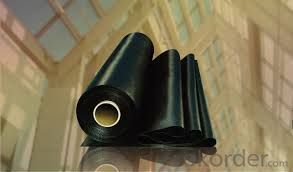
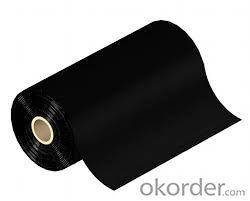
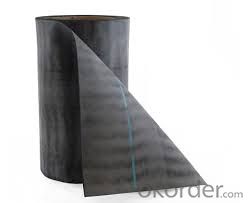
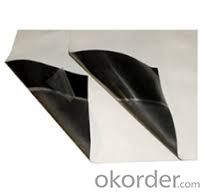




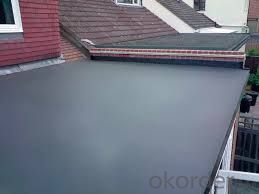
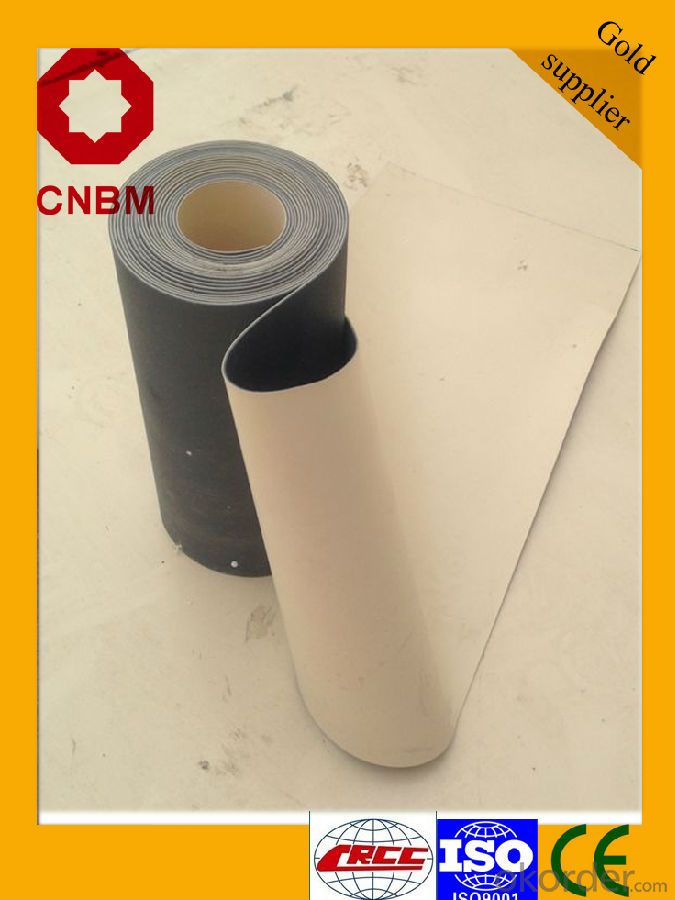
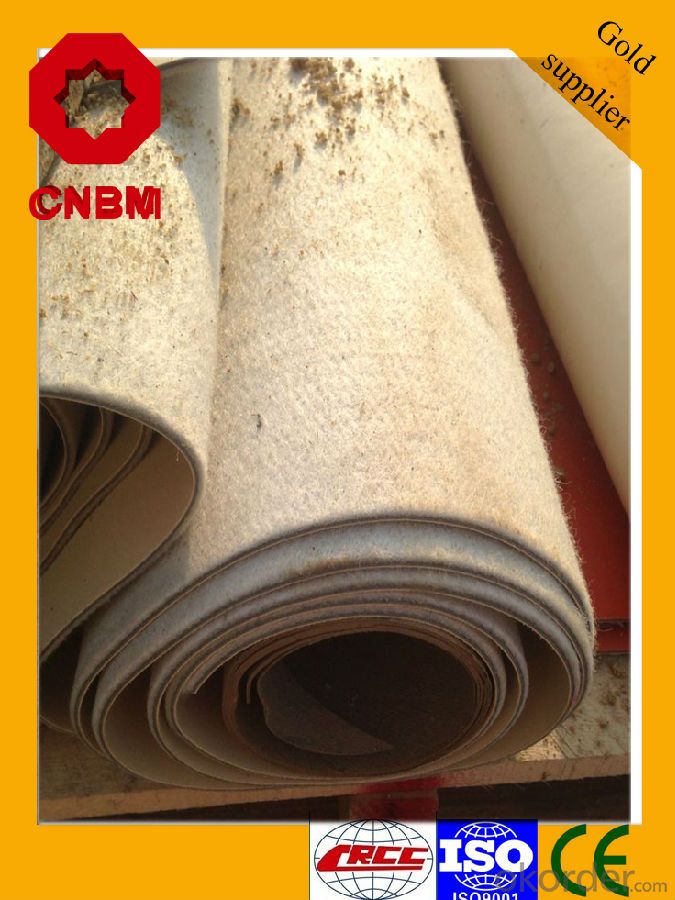
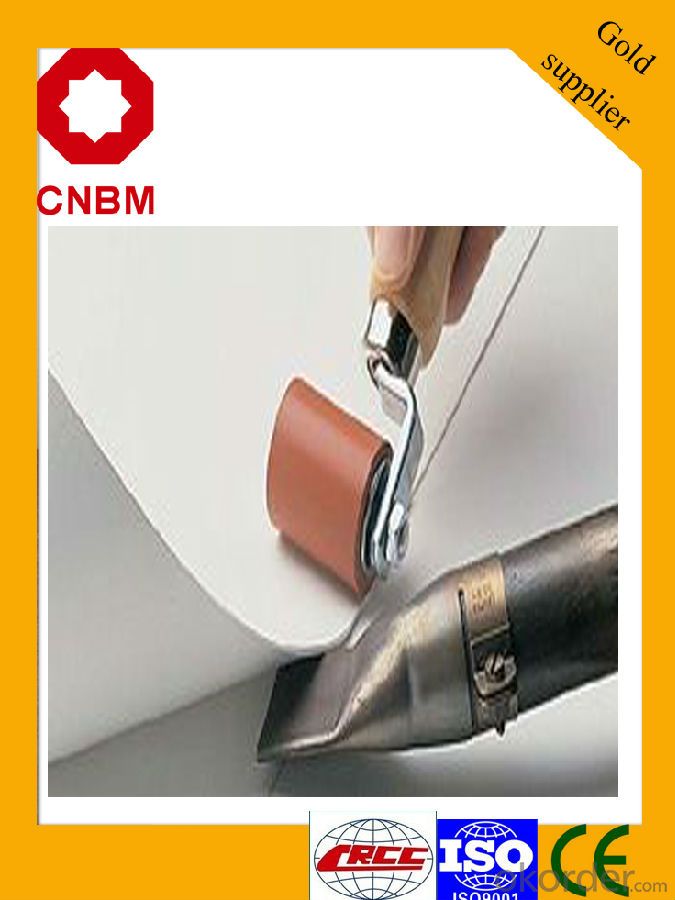

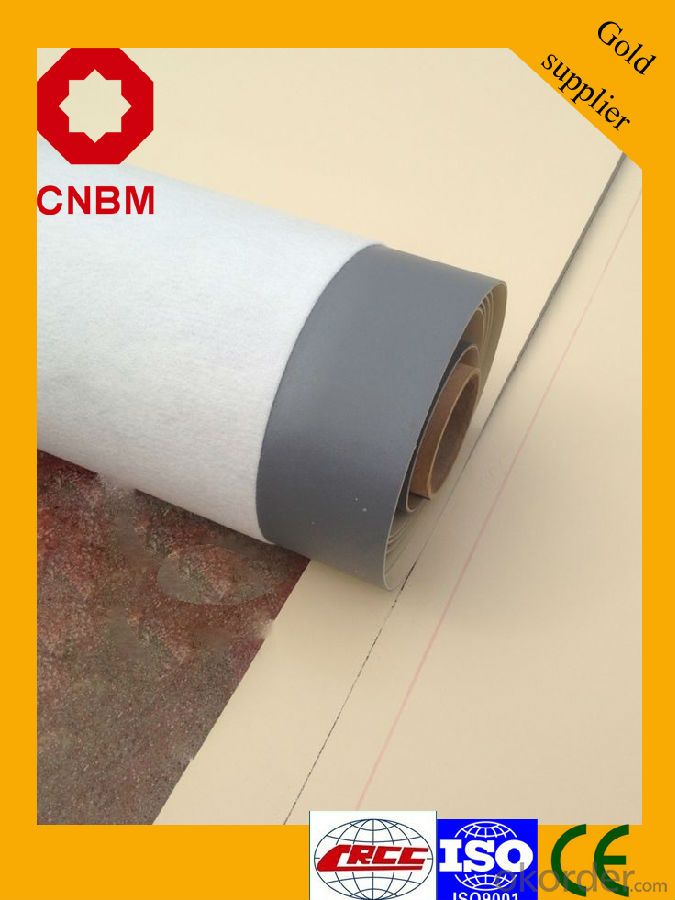
FAQ
Q: What's the de6abf1fe186f8d58506cbcfe46eed814d.jpglivery time ?
A: 3-5 days for 1-600 rolls, 10-15 days for container.
Q: What's the payment terms ?
A: TT/LC
Q: How do you make replacement with quality problems ?
A: New replacement will be packed into your next order or send to you directly after receive video or photo about quality problems.
- Q:Can a waterproofing membrane be used for railways or train stations?
- Yes, a waterproofing membrane can be used for railways or train stations. Waterproofing membranes are commonly used in infrastructure projects to prevent water infiltration and protect structures from moisture damage. In railway or train station settings, they can be applied to various areas such as tunnels, platforms, or underground structures to ensure long-term durability and prevent water-related issues.
- Q:Can a waterproofing membrane be used on green roofs?
- Yes, a waterproofing membrane can be used on green roofs. It is an essential component of the green roof system as it prevents water from penetrating the roof structure and causing damage. The waterproofing membrane ensures that the roof remains watertight and protects the building below from potential leaks.
- Q:Are waterproofing membranes resistant to hydrostatic pressure?
- Yes, waterproofing membranes are designed to be resistant to hydrostatic pressure. Hydrostatic pressure refers to the pressure exerted by water when it is at rest. When a building is exposed to water from the ground, such as in basements or foundations, hydrostatic pressure can become a significant concern, as it can cause water to seep through the walls or floors. Waterproofing membranes are specifically engineered to withstand and resist the pressure exerted by water, ensuring that it does not penetrate into the building structure. These membranes are typically made from materials such as bitumen, rubberized asphalt, or synthetic polymers, which have excellent water resistance properties. Moreover, waterproofing membranes are designed to create a continuous barrier against water, preventing any potential leaks or seepage. They are applied in multiple layers, ensuring a strong and durable barrier that can withstand the high pressure exerted by water. It is important to note that the resistance to hydrostatic pressure may vary depending on the type and quality of the waterproofing membrane used. Therefore, it is crucial to choose a high-quality membrane and ensure proper installation to maximize its effectiveness in resisting hydrostatic pressure.
- Q:Can a waterproofing membrane be applied on top of roofing materials?
- Applying a waterproofing membrane on top of roofing materials is a common practice in the construction industry. This is crucial for areas with heavy rainfall or extreme weather conditions, as it provides an extra layer of protection against water infiltration. The waterproofing membrane acts as a barrier, preventing water from seeping through the roof and causing damage to the underlying structure. It is worth noting that depending on the type of membrane used, it can also improve insulation and enhance the energy efficiency of the building. To ensure the effectiveness and longevity of the waterproofing system, it is important to follow proper installation techniques and adhere to the manufacturer's guidelines. It is advisable to consult with a professional roofing contractor or waterproofing specialist to determine the most suitable membrane and installation method for your specific roofing materials and conditions.
- Q:Can a waterproofing membrane be used in residential buildings?
- Yes, a waterproofing membrane can indeed be used in residential buildings. In fact, it is highly recommended as it provides an effective barrier against moisture, preventing water damage and mold growth. Waterproofing membranes are commonly used in areas prone to water exposure such as basements, bathrooms, roofs, and balconies. They are typically applied on the exterior or interior surfaces, creating a protective layer that prevents water infiltration. This helps to maintain the structural integrity of the building, extend its lifespan, and enhance the overall comfort and safety of the residents. Therefore, using a waterproofing membrane in residential buildings is a wise investment to protect against potential water-related issues.
- Q:Can a waterproofing membrane be used in bathrooms or showers?
- Yes, a waterproofing membrane can be used in bathrooms or showers. In fact, it is highly recommended to use a waterproofing membrane in these areas to prevent water damage and leakage. A waterproofing membrane acts as a barrier that prevents water from penetrating through the walls, floors, and other surfaces in the bathroom or shower. It is typically applied before tiling or finishing the surfaces, providing an extra layer of protection against moisture and ensuring that the underlying structure remains dry. This not only helps to prevent mold and mildew growth but also prolongs the lifespan of the bathroom or shower.
- Q:How does a waterproofing membrane prevent water infiltration?
- Waterproofing membranes are specialized barriers used to prevent water from infiltrating structures like buildings or underground structures. They are typically made of synthetic materials like rubber, PVC, or bitumen, known for their water-resistant properties. The primary purpose of a waterproofing membrane is to establish a physical barrier that water cannot penetrate. It is applied to the exterior surface of the structure, creating a continuous layer that tightly adheres to the substrate. This effectively blocks water from seeping through cracks, joints, or porous surfaces, redirecting it away from the structure. One of the main ways in which a waterproofing membrane prevents water infiltration is by providing a seamless and impermeable layer. This means there are no gaps or weak points that would allow water to enter. Multiple layers of the membrane are often applied to ensure a durable and watertight seal, effectively stopping any water from penetrating the structure. Furthermore, waterproofing membranes are designed to withstand water pressure. They can endure the hydrostatic pressure exerted by water and prevent it from entering the structure. This is particularly crucial for below-ground structures like basements or foundations, which are prone to groundwater infiltration. In addition, waterproofing membranes often come with additional features to enhance their effectiveness. These may include additives or properties that improve flexibility, durability, or resistance to environmental factors like UV rays or chemicals. These properties ensure the membrane remains intact and functional over time, effectively preventing water infiltration. To sum up, waterproofing membranes prevent water infiltration by establishing a seamless and impermeable barrier that water cannot penetrate. They are designed to withstand water pressure and are applied to the exterior surface of structures to block water from seeping through cracks, joints, or porous surfaces. With their additional features, waterproofing membranes provide long-term protection against water infiltration.
- Q:Does a waterproofing membrane prevent water damage to building materials?
- A waterproofing membrane is specifically designed to shield building materials from water damage. Its purpose is to act as a barrier, preventing water from infiltrating the structure and causing harm. Typically, the membrane is applied to areas prone to water intrusion, such as roofs, basements, and foundations. By creating a watertight seal, it effectively stops water from seeping through and harming the building materials. This safeguard is essential in maintaining the structure's integrity and preventing issues like mold growth, rot, and material decay. However, it's crucial to acknowledge that the effectiveness of a waterproofing membrane can vary based on the product's quality and proper installation. Regular maintenance and inspections are also necessary to ensure the membrane remains intact and continues to safeguard against water damage.
- Q:Can waterproofing membranes be used on concrete manholes?
- Yes, waterproofing membranes can be used on concrete manholes. These membranes are specifically designed to create a barrier against water infiltration, protecting the structure from damage caused by moisture. Applying waterproofing membranes on concrete manholes can help prolong their lifespan and prevent issues such as leaks and deterioration.
- Q:Is a waterproofing membrane resistant to gasoline or other petroleum-based substances?
- Yes, a waterproofing membrane is generally resistant to gasoline and other petroleum-based substances.
1. Manufacturer Overview |
|
|---|---|
| Location | |
| Year Established | |
| Annual Output Value | |
| Main Markets | |
| Company Certifications | |
2. Manufacturer Certificates |
|
|---|---|
| a) Certification Name | |
| Range | |
| Reference | |
| Validity Period | |
3. Manufacturer Capability |
|
|---|---|
| a)Trade Capacity | |
| Nearest Port | |
| Export Percentage | |
| No.of Employees in Trade Department | |
| Language Spoken: | |
| b)Factory Information | |
| Factory Size: | |
| No. of Production Lines | |
| Contract Manufacturing | |
| Product Price Range | |
Send your message to us
Spunbond Polyester Mat /filament Polyester Mat For APP/SBS Waterproof Membranes
- Loading Port:
- Shanghai
- Payment Terms:
- TT OR LC
- Min Order Qty:
- 1000 m²
- Supply Capability:
- 200000 m²/month
OKorder Service Pledge
OKorder Financial Service
Similar products
New products
Hot products
Hot Searches
Related keywords


